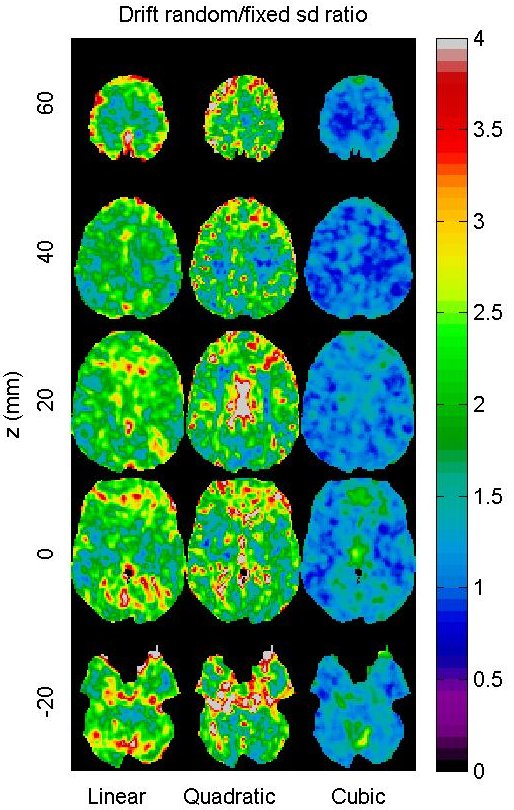



Summary
We investigate the possibility of recovering the information in the drift in fMRI data, paralleling the recovery of inter-block information in ANOVA [1].
Introduction
Sometimes an fMRI stimulus is presented in very long blocks, or else is slowly varying with time, so that it closely resembles drift, which is usually modelled as splines or low-frequency cosines [2-6]. When these are added to the linear model for the fMRI data, such a stimulus is almost confounded with the drift, making the stimulus very difficult to detect.
Methods
An alternative is to model the drift as a random effect, rather than a fixed effect. Then if the fMRI data shows a consistent temporal trend (over subjects), then this can be attributed to the stimulus, and not the drift.
The appropriate analysis can be performed by fitting a mixed effects model using ReML [7-9] with stimulus as the only fixed effect, and drifts as random effects. Unfortunately the estimates of the fixed effects at the runs level depends on parameters estimated at the subjects level, so a hierarchical analysis as in [7-9] is not possible.
However this analysis is only valid if the drift varies randomly across subjects with mean drift coefficients of zero (over subjects). We investigate this hypothesis below.
Results
We chose the FIAC contest data [10] with 14 subjects, and two event and two block design runs per subject. The block lengths were short so that the stimulus was not confounded with the drift. We modelled the drift as a cubic with terms symmetric about the mid-point and scaled from -1 to 1 (0 to 1 for the quadratic).
The effects of the three drift terms were estimated on each run, then combined over runs using a fixed effects analysis, then combined over subjects using a mixed effects analysis, exactly as in [10].




The P=0.05 threshold for a whole brain search of the T statistic images (Figure 3) is +/-5.67, so we conclude that there are consistent linear and quadratic drift effects, but not cubic.
The ratio of random/fixed effects sd image (Figure 4) shows that there are random effects for both linear and quadratic drift that are more or less uniform throughout the brain, averaging at about 2.5. However the cubic drift term shows no evidence of a random effect, since the sd ratio is very close to 1 throughout the brain.
Conclusions
Unfortunately the results of this study show that recovering the information in the drift, as advocated above, is impossible. This is because the linear and quadratic drift exhibit consistent non-zero effects across subjects. In other words, if the stimulus varies in a linear or quadratic fashion then it is impossible to distinguish from drift.
The cubic drift term appears to show no consistent effects, but on the other hand there is no evidence of a random effect either. This suggests that the cubic term can be ignored altogether.
References
[1]Yates(1939). Annals of Engenics,9:135-156.
[2]Smith(1999). NeuroImage, 9:526-533.
[3]Tanabe(2002). NeuroImage,28:902-907.
[4]Friman(2004). NeuroImage,22:645-655.
[5]Long(2005). NeuroImage,28:890-903.
[6]Lund(2006). NeuroImage,29:54-66.
[7]Worsley(2002), NeuroImage,15:1-15.
[8]Beckmann(2003). NeuroImage,20:1052-1063.
[9]Friston(2005). NeuroImage,24:244-252.
[10]Taylor, Worsley(2006). Human Brain Mapping, in press.